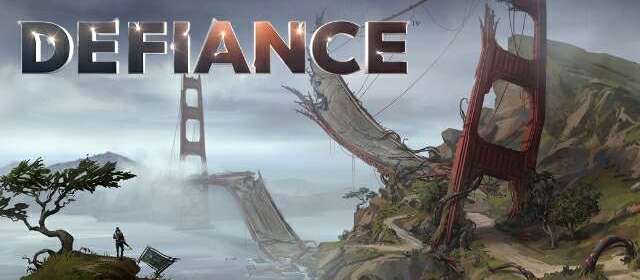Games based on TV shows are hardly a new concept, but it’s rare to see a game designed to work alongside a running show. Trion Worlds’ Defiance shares a universe and, at times, storyline with SyFy’s new action serial of the same name, transporting players to a terraformed, alien Earth recovering from a devastating cataclysm and decades of warfare.
The Votan, a collective of five alien races from a single star system, came to Earth after 5,000 years spent in stasis during interstellar travel, fleeing their own collapsing system. Arriving in 2013, a small number were granted asylum in Brazil, while the rest were forced to remain in stasis while they negotiated with world leaders for a new place to call home. For years tensions escalated, until a Votan ambassador was assassinated on live TV by a human supremacist and the Pale Wars began, condemning thousands to death on both sides.
The war finally came to a head when the fleet of Votan ships known as “Arks” mysteriously exploded in orbit, killing hundreds of thousands of Votan and raining advanced terraforming material onto the world that altered the landscape, geology and ecosystem of the Earth, creating new species of flora and fauna and reshaping the face of our planet. Periodically since, debris falls from the Ark-Belt that now surrounds the Earth, and mercenaries known as Ark Hunters race each other to the crash-sites in a bid to salvage priceless scraps of alien technology. In the meantime, mutants and bizarre hybrid creatures plague the new world, resulting in a kind of sci-fi Wild West setting that resembles a chimera formed of Firefly, Falling Skies and Battlestar Galactica.
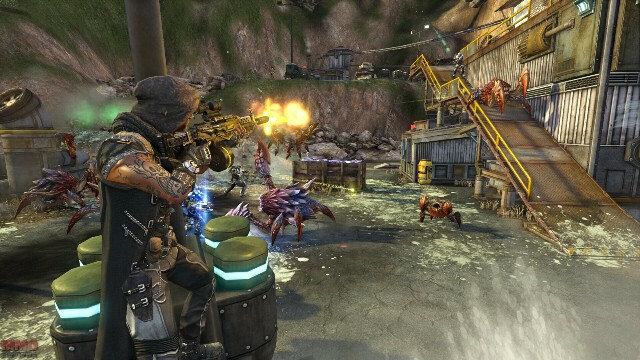
While the TV show follows the fortunes of Joshua Nolan, sheriff of the frontier town of Defiance, the game’s plot is more general and all-consuming, putting you in the shoes of an Ark Hunter whose quest for loot and salvage is intertwined with the search for Karl Van Bach, a powerful magnate who funds the Ark-Hunting expeditions. The story itself is long and multi-branching, the foremost branch seeing you team up with Cass Ducar, an alien Ark Hunter who is the first person you meet when the military cruiser you’re travelling on crashes to the terraformed Earth. A good deal of the opening hours involve re-establishing communications arrays and securing a manageable base of operations for the surviving Earth Republic (or E-Rep) soldiers, led by the surly General Grant.
The second branch follows more closely the events of the TV show (and in fact missions for both story arcs are designated separately on the game’s map), and allows you to rub shoulders with characters from the small screen, beginning with Nolan himself and his adopted daughter Irisa – also an Irathient like Cass. It’s fair to say that these characters are more fleshed-out than even the main supporting cast of the game itself and convey more personality and depth, perhaps due to the authenticity of the voice-work.
The world of Defiance – focused around a terraformed, unrecognisable San Francisco Bay area – is surprisingly deep, the various alien races (who, besides the Irathient, are sadly not playable at this point – though we can only hope for future DLC to makes them so) each possessing their own history, religion and lost culture. There’s a diversity not only to the species themselves, from the humanoid, mildly-Klingon Irathient to the ghostly, hairless Indogenes, but also within each species, as elder generations that existed before stasis often clash with the younger generations born on Earth. As with Mass Effect, an in-game codex (albeit a stripped down, bare essentials version) provides details about the elements of the world, its rules and its backstory.
The simple fact, however, is that like any MMO, it’s not really the story that compels you, and you’ll frequently find yourself off doing anything but the narrative missions to earn a decent wedge of the game’s several currencies with which to buy or upgrade your gear. Side missions abound, asking you to do anything from shutting down computer grids to rescuing wounded E-Rep soldiers and, when combined with the ridiculous amount of challenges available, the package starts to look like incredible value for money. Dotted all over the expansive map, challenges range from timed combat runs to checkpoint races (with several variations of each available) and reward you with weapons and cash for your trouble.
Although outwardly substantially more, at its heart Defiance is a Third Person shooter with RPG elements (think Borderlands with more players, though considerably less variety in enemies and character development). Left trigger (for consoles and control pad PC gamers) aims, right trigger destroys; grenades are assigned to RB and special powers are activated with LB (more on those shortly). You have a combat roll for evasion, but there’s no dedicated snap-to-cover mechanic, which is a shame as there are times when effective use of cover would come in very handy.
Your Ark Hunter is created from one of four race/gender combinations (Human or Irathient male or female) and several archetypes: Survivalist, Outlaw, Machinist and Veteran. Sadly, the choice of starting “class” is almost entirely cosmetic, affecting nothing but your first weapon (which you’ll have swapped out within the hour) and your outfit (again, interchangeable after a few hours of play). There is a decent selection of heads, faces, hairstyles, tattoos and skin tones to create a unique character, and with a vast amount of outifts to find or buy (either through in-game currency or microtransactions). The scope to mould a one-of-a-kind avatar is impressive – just don’t expect it to have anything to do with your initial choice of class and race.
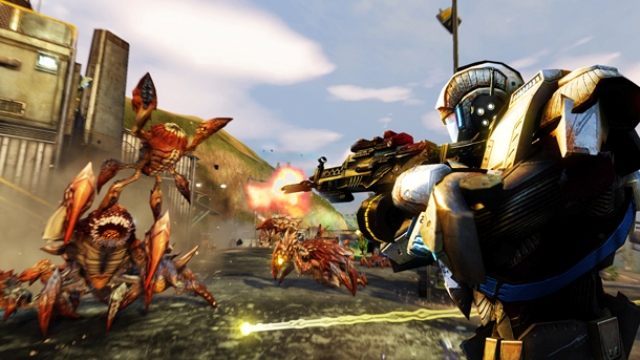
Each Ark Hunter is implanted with an EGO (Environmental Guardian Online) device, which effectively explains away the HUD and gives you a persistent guide through Defiance’s deadly landscape. The EGO device is your one-stop shop for inventory management, weapon modification, character development, help and settings menus, and the Defiance online store. Apart from this, the EGO also allows you access to four parent “powers” that dictate which perks you can assign and how you approach an encounter. These powers are Cloak, which is fairly self-explanatory; Overcharge, which adds impact to your shots; Decoy, which creates a copy of you to fool enemies and Blur, which allows a short dash to increase melee power and evade enemy fire. Each is upgradeable and linked to a handful of perks associated with it. For example, perks connected to Cloak allow you to deal more damage from behind an opponent, or increase your critical chance when firing from a crouched position.
Ostensibly, these skills are great – and for the individual player they make a real difference in the field. Unfortunately, they don’t compliment one another in any meaningful way, and they aren’t disparate enough to make you agonise over your choices. For example, a dedicated Medic path seems like a no-brainer, but Trion Worlds leave such an option out of Defiance altogether. More cues from Borderlands would have been welcome here to create a genuine balance between solo talents and abilities that work together to necessitate teamwork. As it is, Defiance is a massively multiplayer game that caters far too well for the lone wolf. In fact, it doesn’t do a great deal to encourage real team play at all. The higher level you reach, the more powerful these skills become, but they will rarely develop into something that another player would seek you out to provide.
The gameplay itself, thankfully, is a more varied and compelling affair. As mentioned, the story missions follow two branches, but if you don’t fancy pursuing them you can take on the huge amount of side missions, random encounters and challenges in order to complete “Pursuits”, stackable, persistent goals that reward you for almost everything you do from killing enemies with certain weapons to travelling long distances in your summonable vehicle (which is brilliant, by the way). Added to this are Arkfalls, special events that see the Ark-Belt shed its valuable debris in a hail of meteorites. The sky churns with fire and lightning, the wind howls around you and a giant crystal slams into the Earth. Your job is to destroy the crystal while battling the hordes of enemies that swarm around it. Some are single falls, and others feature several falls that follow a pattern until what can only be described as a boss fight ensues.
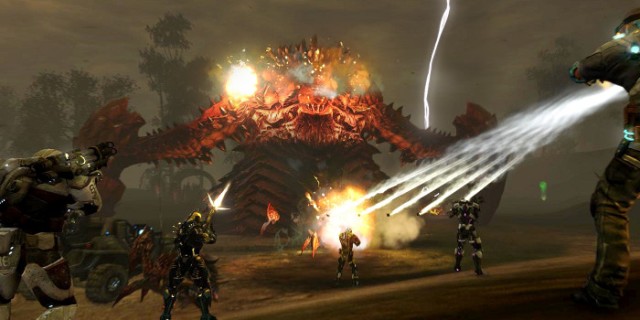
The most fun are the Arkfalls that feature Hellbugs (giant, mutated insects that resemble Half-Life 2’s headcrabs, only bigger and angrier), as these often culminate in what amounts to a raid boss, a colossal maw that spits various-sized Hellbugs out in quick succession, including enormous Hellbug Monarchs. Kill the Monarch and the maw will release a winged symbiont with a crazy amount of health and some devastating attacks. If you can kill it, you win the event and reap the rewards. Only the foolhardy attempt Arkfalls alone, however, and you’ll usually find yourself engaged alongside ten or twenty other players. You don’t have to group with them if you don’t want to, and there’s a wonderful feeling to fighting side-by-side against waves of Hellbugs and mutated soldiers, only to saddle up without a word once it’s done and simply bugger off on your own again. It’s seamless drop-in, drop-out without the need for waiting or grouping and, as such, it’s brilliant.
Of course, should you choose to play multiplayer, there are options available to you. Contracts are specifically designed for co-operative play, and allow you to form groups to tackle large-scale jobs for various businessmen and Arktech magnates. These don’t really play very differently from the main game, except you have to be in a group to attempt them and the rewards are greater. Should you favour player versus player (PvP) combat, you can enter instanced battlegrounds to become Shadow Operatives, and compete in team games and deathmatches. The lag is slightly more noticeable here than in the main game – though I never found it to be game-breaking – but the action is more intense and streamlined. As a single player gamer by preference I don’t spend much time playing competitively, but Defiance offers a fairly robust package for those who choose that road. Making the battlegrounds instanced is a great idea, too, as it prevents griefing in the “solo” campaign. Of course, if you wish, you can form a group to tackle every single mission in the main game.
Controlling your Ark Hunter is fluid enough. The vehicles don’t handle very well, but their unwieldiness adds to the manic speed-thrills of charging across the rocky landscape with the boost button held down, hitting a random jut of rock and launching yourself thirty feet into the air. Everything about Defiance is a little rough around the edges, but every scuff and blemish adds character and charm to what could have been a very barren, lifeless online world. There are some issues with the UI, and the menus can seem a little clunky at times, but this is likely a side effect of designing a system that straddles the line between console and PC; it doesn’t always work, but by all accounts it’s more intuitive with a pad than a keyboard.
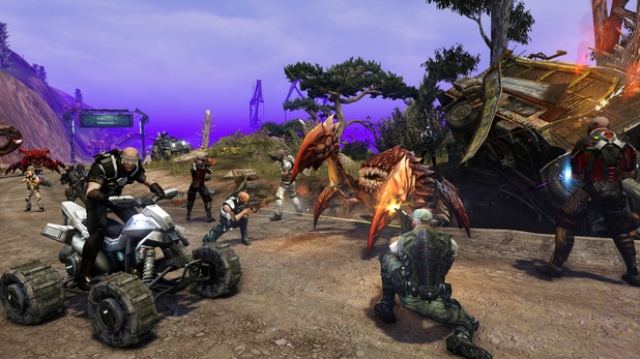
On the face of it, the aesthetics aren’t that great. Obviously this is a huge and persistent world, and it’s just not feasible during the development of such to pour resources that are needed elsewhere into the graphics. However, Defiance suffers from some extreme screen tearing and latent texturing on the Xbox 360 version. I can only imagine that the PlayStation 3 version suffers something similar, although it may be less of a problem for PC gamers, which looks better overall. There isn’t a great deal of slow-down, even during the mass fights, which is quite impressive, and I haven’t experienced an awful lot of lag although it has been noticeable.
Concerning the art itself, there’s little to get excited about. The world is incredibly brown, and many of the environments – ranging from wooded hillsides to abandoned, gutted towns and the scorched, rusted remnants of industry – are bland and uninspired. The world is not without its own sense of atmosphere, though, and the oppressive desperation of war-torn San Fran is conveyed through the medium of smashed bridges, deserted gas stations and crumbling highways.
Character models are hit and miss, too. The Ark Hunters have a production line-style efficiency to them, but there are enough possible variations that very few players look alike until they start pulling on the heavy-looking armour outfits – which, again, have many variables. Characters from the TV show are recognisable, and the lip-synching is adequate – the biggest problem is with identikit enemies. Hellbugs are excusable (they’re giant bugs), but the mutants and humanoids come in several flavours that are recreated over and over. You might be fighting four or five types of mutant at once, but you’ll be up against three or four identical copies of each. It’s not a major complaint, in fairness, as all games are guilty of this, but there’s so much combat in Defiance that it is noticeable.
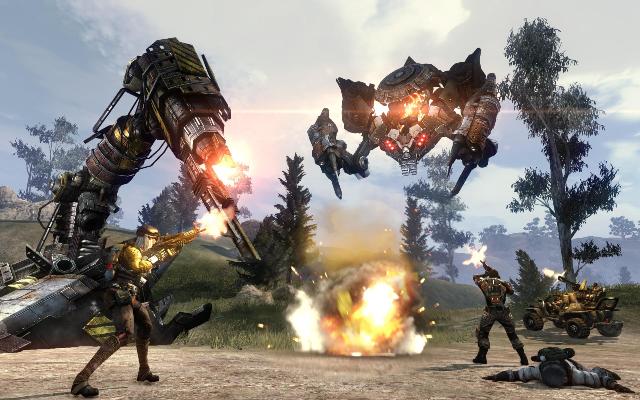
The sound direction, as expected, features lots of things blowing up, but Defiance’s world – particularly in combat – is a busy one. Gunfire is always sounding from the distance, explosions rattle the battered old towns and when you throw a big group of Ark Hunters together against, say, an Arkfall, the sense of immersion afforded by all the ambient sound effects and shouted orders or selectable emotes is fairly impressive. The voice work is never more than decent, the notable exceptions being Grant Bowler’s turn as Nolan; by comparison, characters like Cass Ducar and the EGO spectre sound a little phoned-in at times. There are occasional issues with synchronicity, where dialogue won’t kick in on time or sound effects don’t trigger at all. It’s not regular but it can be annoying, although such things will surely be patched in the future.
VERDICT: With the TV show kicking off this week, we’ll be able to see just how tied-in the two mediums are, and how much extra clout the series will afford the MMO. Potentially, it’s a risky venture but, let’s be honest, most people who bought the game will be tuning in to at least the pilot. Either way, as a standalone game Defiance finds its feet and remains vertical. Small bugs and glitches nibble away at the overall experience without ever managing to break the gameplay in any real way, and you really have to admire Trion Worlds’ ambition – especially concerning the console versions. A PC-only release for Defiance would have been a no-brainer and, while it remains to be seen just how successful it will ultimately be on consoles, you have to give them credit for attempting to bring something new to the 360 and PS3.
Defiance is a fun shooter with more than a hint of the Red Faction franchise about it, decked out with a huge amount of loot and customisation set in a massive world with an engaging backstory. The plot itself might be a bit straightforward, but it remains uncluttered and fit for purpose, and stands to be leant real credence by the tie-in TV show. The MMO elements are unobtrusive, which means it caters for team-players and lone wolves alike, and the complete package is more than worth the money for those who like their shooting to be that little bit more social.

GOOD. A game that scores 7/10 is worthy of note, but unworthy of fanfare. It does many things well, but only a few of them incredibly well and, despite a handful of good qualities, fresh ideas and solid mechanics, it fails to overwhelm.


